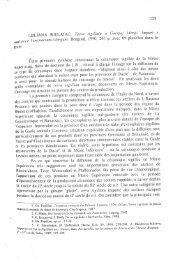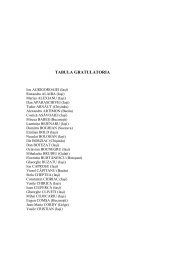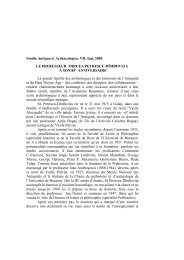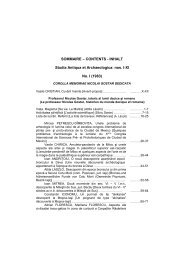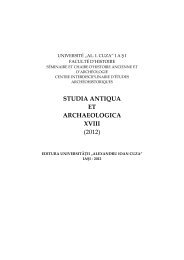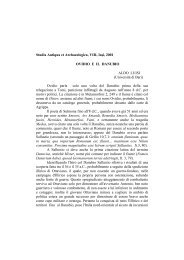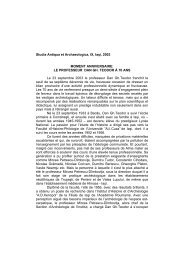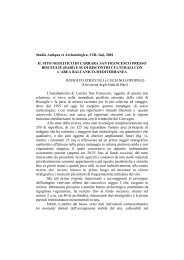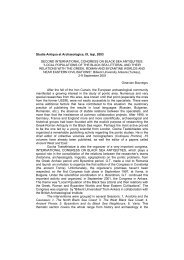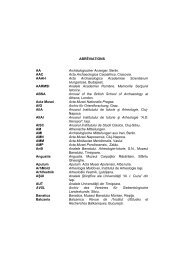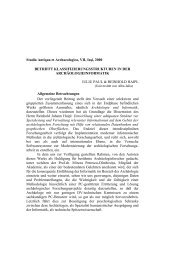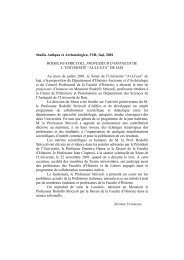VALERIU SÎRBU, Arheologia funerară şi sacrificiile: o terminolo
VALERIU SÎRBU, Arheologia funerară şi sacrificiile: o terminolo
VALERIU SÎRBU, Arheologia funerară şi sacrificiile: o terminolo
You also want an ePaper? Increase the reach of your titles
YUMPU automatically turns print PDFs into web optimized ePapers that Google loves.
Studia Antiqua et Archaeologica, X-XI, Ia<strong>şi</strong>, 2004-2005<br />
COMPTES-RENDUS<br />
<strong>VALERIU</strong> <strong>SÎRBU</strong>, <strong>Arheologia</strong> <strong>funerară</strong> <strong>şi</strong> <strong>sacrificiile</strong>: o <strong>terminolo</strong>gie<br />
unitară [Funerary Archaeology and Sacrifices: An Unifying<br />
<strong>terminolo</strong>gy], Istros Publishing House, Brăila, 2003, 123 p. (out of<br />
which 14 plates)<br />
The preoccupation of the researcher Valeriu Sîrbu for the funerary<br />
field is not a new one, as it can be seen from the short biographic<br />
presentation at the beginning of the book. Completely new in the present<br />
volume is the computerized approach to the subject of funerary<br />
archaeology. Books talking about the use of computer in archaeology are<br />
rare in the Romanian literature. We can mention the one written by Gh.<br />
Lazarovici and D. Micle 1 , which tries to survey a series of computer<br />
programs and statistic notions, difficult to understand by a person without<br />
a minimum background in the informatics field. Another book belongs to<br />
Irina Gavrilă 2 and enters our field of interest only because it explores this<br />
new tendency of explaining the ways in which the computer can be<br />
successfully used in the field of humanistic studies. These two books,<br />
together with the one presented here are important steps on the way of<br />
trying to modernize the historic research. We take the opportunity of<br />
reminding that in the occidental space these practices are so common that<br />
about them is written only as part of a chapter in a manual of archeological<br />
theory, without being assigned special volumes. But as such a manual<br />
doesn’t exist in the Romanian space (with the exception of the attempt of<br />
M. Ciută 3 ) we are not surprised by the choice of the author of approaching<br />
this subject in an independent book. When watching critically this volume<br />
arouses a difficulty, given by its interdisciplinary character: one does not<br />
know what to analyze: the book itself or the database created and<br />
presented in it.<br />
The volume has a bilingual edition (Romanian and English). With<br />
regrets, we must mention that the praiseworthy step of presenting, in<br />
parallel, an English translation (which, on one hand, would help to a better<br />
circulation of the volume and, on the other hand, offers a useful dictionary<br />
1 Gh. Lazarovici, D. Micle, Introducere în arheologia informatizată, Timişoara,<br />
2001.<br />
2 I. Gavrilă, Statistică matematică <strong>şi</strong> informatică în cercetarea istoriei, Brăila, 2003.<br />
3 M. Ciută, Metode <strong>şi</strong> tehnici moderne de cercetare în arheologie, Alba Iulia, 2003.
202 COMPTES-RENDUS<br />
of specializes terms) begins<br />
with a translation mistake right in the title: an unifying. It would have been<br />
correct to say a unifying, u being, in this situation, a semi-vowel which<br />
behaves like a consonant in the case of articles (definite or indefinite).<br />
The book’s structure is simple, opening with an Introduction (I., p.<br />
7-14) followed by two chapters which constitute the body of the work:<br />
Funerary archaeology and sacrifices (II., p. 15-53) and Clay vessels from<br />
the Geto-Dacian world (III., p. 55-77) and ending with the Bibliography<br />
(IV., p. 79-80) and the Illustration (V., p. 81-123).<br />
In the Introduction, the parts that make up the book are presented<br />
and explained, with the mention that the volume had in view especially the<br />
Thracian world (p. 7). This aspect is obvious all along the book, reason for<br />
which we consider that the title of the volume should have expressed this<br />
more clearly. Another statement which practically excuses all the possible<br />
shortcomings of the work is that the created system is one that is opened<br />
to any kind of data, data that even was not perceived by the authors, or<br />
will appear in the future discoveries (p. 8). The database is presented as<br />
split into two large parts (the funerary domain and non cremated human<br />
bones in non-funerary contexts), each of these being structured on three<br />
levels (the monument’s type and its essential characteristics, the<br />
archaeological complexes in which the dead were discovered and the<br />
dead with its personal characteristics and its grave goods (p. 8). The<br />
difficulties of the systematization of the data due to the lack of sufficient<br />
information for the cases researched up to the present moment were also<br />
described in this introductory part. It is a pity that the author didn’t offer<br />
some more clear models for the registration of the data on the field, fact<br />
which would have assured a better way of keeping track of the<br />
information. The hardware and software information related to the created<br />
database were presented at the end of the Introduction (p. 13-14).<br />
The second chapter, dealing with the funerary archaeology and<br />
sacrifices, is structured in two main parts: a dictionary of terms and a<br />
general lexis (if we are to follow the author’s own translation, even if<br />
dictionary of terms looks very much like a pleonasm.<br />
The Dictionary of terms tries to define the general terms of the<br />
funerary field with the desire / hope of stimulating a future unified<br />
language which would eliminate the so frequent confusions due to the<br />
more or less chaotic use of specialized terms. The words that are more or<br />
less ambiguous were followed by commentaries that try to explain the<br />
choice made by the author. One of the most interesting terms, largely<br />
discussed, is that of cemetery / necropolis (p. 16-17). The statement that
COMPTES-RENDUS 203<br />
“it is only in advanced civilizations and in exceptional ways that some<br />
necropolis or tombs were found in the habitat” can apply only in the case<br />
of the necropolis, isolated tombs inside the habitat being a frequent<br />
discovery in the period anterior to the appearance of the necropolis. The<br />
attempt to set some numerical limits for considering a discovery as<br />
belonging to a necropolis or to a group of tombs is interesting and<br />
praiseworthy, even if the limit of six tombs for a cemetery seems to us a<br />
little to low.<br />
Another interesting group of commented terms is that composed of<br />
putting into ground, inhumation and burial (p. 18-19). The sensible<br />
differences observed and established between these three terms can be<br />
marked as a model of analysis for other terms that belong to the<br />
archaeological vocabulary, with the condition that such an enterprise<br />
should not remain at the theoretical level, but must be also put into<br />
practice. Another similar pair of words is formed by funerary inventory and<br />
grave goods (p. 18, 20).<br />
One of the terms for which the attempt of definition was not<br />
completely successful is that of tomb / grave (p. 21). It is said that one of<br />
the characteristics of the grave is “the deposition in an established place<br />
(cemetery)”, being forgotten the cases of isolated tombs or those in small<br />
groups which do not belong to a cemetery. Another term with whose<br />
definition we do not agree completely is that of sacrifice (p. 25). It is<br />
asserted that this would imply also the “offering of other goods (food,<br />
liquids, weapons, ornaments etc.)”, while these would better fit the<br />
funerary offering category, according to the definition of this term (p. 21).<br />
The General lexis presents the component elements of the data<br />
base up to its last ramification. If the logical structure of the database<br />
doesn’t come out very clear from the presentation made to it in this part of<br />
the volume, the lexicon can be taken as a model for the registration of the<br />
information, both because of the systematization of its various segments<br />
and because it offers a pack of clearly defined terms. We cannot avoid<br />
underlying certain shortcomings (which could be overcome at an ulterior<br />
moment) and even some errors (we consider them such).<br />
Thus, in the case of “non-cremated human bones in non-funerary<br />
contexts” (p. 26), we have “inhumation as a result of natural death<br />
(infants)” for the “02” code. Our observation is that as long as we are<br />
talking of an inhumation, be that the one of an infant, the context cannot<br />
be but funerary, which does not fit the group into which was placed that<br />
particular entry.
In the case of the<br />
larger group, II, of funerary monuments (p. 26-30), it would have been<br />
more logical that the first sub-groups be presented in another order, such<br />
as II.3 (types of monuments), II.2 (types of graves0, II.1 (types of rites in<br />
necropolis, groups of graves and single graves), going from general to<br />
particular.<br />
More observations are to be made for the part were the deceased<br />
are discussed (p. 33-36):<br />
- there is no section designed for the presentation of the state of the<br />
grave or of the skeleton;<br />
- when discussing the sex (p. 34), the entries “01. no data available”<br />
and “04. unidentifiable (copil)” are not sufficient to cover all the<br />
situations in which there is a lack of data. Three entries: “the<br />
anthropological analyses have not been done”, “unidentifiable” and<br />
“unidentifiable (copil)” can explain more clearly the exact situation<br />
for each skeleton. We make this observation because one of the<br />
declared aims of the database is to facilitate the more rapid and<br />
easier exchange of information among specialists and a<br />
registration of the “no data available” type does not explain the<br />
reason for which there is this lack of data. If the reason is clearly<br />
expressed, this could determine the ulterior taking of a correct<br />
decision (if there is no data because the anthropological study<br />
have not been done, then it should be seen if this expertise can be<br />
done, or if there is no data because the skeleton was into a<br />
fragmentary state, then someone can direct its interest toward<br />
genetic analyses).<br />
- when talking about dimensions (p. 34), another category, that of<br />
“stature” (which differs from the skeleton’s length) should be<br />
introduced along with its sub-categories, according to sex: small,<br />
under-medium, over-medium, medium, tall etc.).<br />
- the attempt of setting some precise limits for the various degrees<br />
of crouching (p. 35) is praiseworthy, but the limit of 100 º for a weak<br />
crouching seems to high for us. We think that this limit should be<br />
lowered toward 140-145-150 º 204 COMPTES-RENDUS<br />
.<br />
- the “hand position” (p. 35) offers a too small number of variants<br />
compared with the realities observed in the field and the position<br />
“05. hands are in different position compared to one another” is<br />
superposed by the positions “07.” and “08.”, which refers to a hand<br />
lying by the body and another hand raised.
- there isn’t any set of variants to describe the position of the legs<br />
and of the head, both these elements being important when<br />
analyzing the funerary rite.<br />
In the set of variants proposed for the description of the inventory<br />
(p. 38-40), the mirror is mentioned both in the “various” category and in<br />
the “toiletry” one, and we do not understand how a miniature spoon can be<br />
a toiletry piece.<br />
The author’s commentaries to the lexicon are presented after that<br />
(p. 53). Although he excuses himself for the possible errors and lacks from<br />
the main lexicon, due to difficulties we understand if we take into<br />
consideration the anterior lack of systematization in the presentation of the<br />
data, we must mention that such error or lacks can lead to un-valid<br />
conclusions.<br />
The second part of the book refers exclusively to the pottery. The<br />
author tried to realize a typology based on a unitary language. Previous<br />
attempts of this kind belong to C. Scorpan4 and to the CIMEC<br />
Organization5 COMPTES-RENDUS 205<br />
. This step was more than necessary for the Romanian<br />
archaeological research where the description of pottery is dependent on<br />
the geometric and culinary fantasy of each researcher, clearly stated and<br />
accepted rules missing. As any systematization attempt, even this one<br />
could be accused of shortcomings and imperfections, but his value is<br />
given by the attempt of “putting some order” into a field whose inconsistent<br />
approach is directly proportional with its importance in the archaeological<br />
research. An observation must be done though. Both at the p. 112 and at<br />
the p. 121 models for the classification of pottery according to their<br />
utilitarian purpose are proposed. This kind of observations, without the<br />
support of special physical-chemical analyses, should be avoided in the<br />
case of a serious attempt to systematize the pottery.<br />
In conclusion, we must come back to the idea that this volume, as<br />
well as the attempt it illustrates, with all the shortcomings inherent to first<br />
steps in such a direction, must be taking into consideration as a model to<br />
be followed, improved and last, but not least, put into practice and even<br />
extended to other fields of archaeological research as well. If this thing<br />
happens, we could then say that we finally evolved from the romantic<br />
archaeology to the level of scientific archaeology.<br />
Raluca Kogălniceanu<br />
4 C. Scorpan, Terminologie arheologică selectivă. Tezaur de termeni, vol. I,<br />
Bucureşti, 1995.<br />
5 www.cimec.ro
206 COMPTES-RENDUS<br />
DUMITRU BOGHIAN,<br />
Începuturile istoriei omenirii [The beginnings of the history of<br />
humankind], Bucovina Istorică Press, Suceava, 2003, 349 p. (105<br />
figures in text)<br />
Appeared in the Archeology series of the publishing house, the<br />
volume has the character of a academically course, being presented by<br />
the author, in the Argumentum, that opens the work, as a “modest attempt<br />
to guide the steps of the students and everyone interested on the path full<br />
of obstacles of knowing the most distant past of mankind”.<br />
The first chapter, Prehistory - start of history (p. 7-20) wants to<br />
familiarize the reader with general and methodological problems tied to its<br />
study: it presented a short history of the various definitions and manners<br />
of approach of the historical study of the beginnings of human society<br />
together with their most representative figures. After a general chronology<br />
of the discussed period, the author continues with a general look over the<br />
interdisciplinary demarche, necessary for studying thoroughly the different<br />
aspects of prehistory. In the next parts of the first chapter are enumerated<br />
and defined the main connected disciplines with the way that they interact,<br />
having as final goal a deeper knowledge of the remote past of mankind.<br />
The second chapter, Nature and man in prehistory (p. 21-32), after<br />
a series of General considerations, witch underlines the importance of the<br />
geographical environment for the historical evolution of man, as well as a<br />
general review of the geological ages in witch this evolution takes place<br />
(The characteristics of natural environment in prehistory), we find a<br />
detailed description of the quaternary, observing the climacteric<br />
phenomenon (the glaciations) and the evolution of fauna and flora (The<br />
natural environment of quaternary).<br />
The third chapter, The process of anthropogenesis (p.33-60), after<br />
the presenting of two most important theories concerning the origins of<br />
man (creation and evolution) and their main supporters, follows the<br />
biological process of formation of the human being, describing in detail all<br />
known stages of the evolution of human type, starting from hominids to<br />
Homo sapiens recens.<br />
The fourth chapter, The development of hunter-gatherer societies.<br />
Paleolithic and Epipaleolithic-Mesolithic (p. 61-144) starts with a short<br />
definition of the period and a quick exposition of the chronological<br />
problems. Then, each period is detailed, through the main archeological<br />
cultures, being treated both material (the specific characteristics of the<br />
stone tools, dwellings) and spiritual aspects (where these are identifiable
COMPTES-RENDUS 207<br />
through archeological finds); the information offered is always correlated<br />
with those presented in the chapter before. We believe though that the<br />
discussions on the religious life of Paleolithic, Epipaleolithic and Mesolithic<br />
communities could have been more detailed and should have touched a<br />
bit more subtle matters. We have in mind here the theories (and their<br />
critics) regarding the existence of totemic practices, which are tightly<br />
bounded, as it is well known, to a very specific type of social organization.<br />
Thus a double finality of the speech would have been realized.<br />
Next chapter, The first societies with productive economy. The<br />
Neolithic and the Aeneolithic (IX/VIII – IV/III Mil. b.C.) (p. 145-200), in the<br />
first part treats widely of general problems of this period, starting with<br />
those concerning <strong>terminolo</strong>gy, chronology and others. We find then large<br />
accounts on agriculture (with a short history on the theories concerning its<br />
appearance, as well as a description of numerous plants cultivated at that<br />
time), cattle breeding, descriptions of technological processes, such as<br />
making and burning ceramic pots, typological presentations of different<br />
tools, ordered by the raw material used (stone, bone, horn, teeth, clay,<br />
copper, wood etc.). Another touched matter concerns the changes<br />
appeared in organizing the community’s habitat (with descriptions of<br />
different types of settlements) and the techniques used in elevating the<br />
inhabitation structures, these being presented in a chronological and<br />
geographical order. The chapter ends with a series of short considerations<br />
on the spiritual life of Neolithic communities and its main characteristics:<br />
the emergence of fertility cult and the Mother Goddess figure, of its male<br />
partner and of the plastic representations of these notions.<br />
Chapter VI, Ethno-cultural processes in world’s Neolithic and<br />
Aeneolithic (p. 201-320), realizes a general review of the archeological<br />
cultures and their main characteristics from Asia, Africa, America and<br />
Europe, with a special look on the territory of Romania.<br />
The work ends with a useful Glossary (p. 321-332) and with a vast<br />
general Bibliography, alphabetically organized (p. 333-349), which, due to<br />
the declared purpose of the book and for an easier use by the reader,<br />
should have been thematically organized. From the same reason we must<br />
notice the poor quality of figures and maps, which we hope to improve in a<br />
future edition. We also recommend a detailed index, in order to make<br />
possible a faster access to the various parts of each chapter. We also<br />
hope that the editor will remove the far too many errors of typing.<br />
At the end, we underline the fact that such a book is a compulsory<br />
presence in the bookshelf of every student or passionate of archaeology<br />
that desires to take note of the general problems of prehistory.
208 COMPTES-RENDUS<br />
George Bodi<br />
MĂDĂLIN CORNEL VĂLEANU, Omul <strong>şi</strong> mediul natural în neoeneoliticul<br />
din Moldova [Man and environment in the Neolithic in<br />
Moldova (north-east of Romania)], Ia<strong>şi</strong>, Editura Helios, 2003, 287 p.<br />
+12 pl.; Aşezări neo-enolitice din Moldova [Neolithic sites from<br />
Moldova (north-east of Romania)], Ia<strong>şi</strong>, Editura Helios, 2003, 233 p.<br />
The two books published by M. C. Văleanu represents, in fact, his<br />
doctoral dissertation (coordonated by Mircea Petrescu-Dîmboviţa). The<br />
two volumes were published in the same year, with the help of Foundation<br />
„Cucuteni for the third Millenium” (Bucharest) and Acremis Society of Ia<strong>şi</strong>.<br />
The first book was designed as an original contribution, using<br />
interdisciplinary research, in an attempt to corroborate the archeological<br />
data with ones provided by the natural science; the data processing was<br />
made using statistic methods. From the foreword, the author declares his<br />
intentions to study the ways in which the human communities from Neo-<br />
Aeneolithic used the natural environment, and to offer an image of man’s<br />
interaction with surrounding environment.<br />
The great effort made by the author to elaborate this vast work is<br />
considerable but the results are not always germane.<br />
The book is structured in six chapters. The first chapter is<br />
concerning with the research history, taking an inventory of the most<br />
representative archeological discoveries, pioneer interdisciplinary<br />
researches, as well as a few papers which submit some interdisciplinary<br />
methods of archeological investigation.<br />
The second chapter (Natural environment) offers geographical<br />
information about the studied area. Thus, the circumscription of the region<br />
is made according to hydrographic basins, and the characteristics of the<br />
natural environment according from geologically and physicalgeographically<br />
point of view is drawn. Nonetheless, the notion of natural<br />
environment is far too large, so we believe that a more detailed approach<br />
to biogeographically problems should have been salutary. The information<br />
concerning each relief unit are abundant, betraying the author’s<br />
geographical background, still being sometimes, irrelevant to the purposes<br />
of the book. This bulk of information is taken, most of it actually, from the<br />
Geographical Treaty of Romania, as the author underlines, but only a few<br />
bibliographical notes have been made.<br />
The third chapter deals with working methodology. In a few<br />
phrases is sketched the archeological <strong>terminolo</strong>gy used, which is based<br />
on the chronological frame of the Neolithic and Aeneolithic cultures
COMPTES-RENDUS 209<br />
studied. Unfortunately, here the author made a regrettable error,<br />
mentioning more than one Historical Treaty of Romanians, published in<br />
2001 (p. 44). Then, the author presents the methods used, which allowed<br />
him to start from the data base to gather new information and statistics.<br />
The data base collects the information concerning the archeological<br />
discoveries attributed to Neo-Aeneolithic period, these being published in<br />
his other book, without any references being made to these in the first<br />
book (Repertoire). The data base is structured in 19 fields, the content of<br />
every field and sub-field being explained. To understand better how a field<br />
is presented we will quote the author: “Field 8-the location of the<br />
archeological site, the data has been introduce as such: N|NE|NV|S|SE|<br />
SV|E|V| total. The total exposure of the area is placed on a flat plateau of<br />
a hill or in the major bed of medium, large, very large size” (p. 49).<br />
Working methodology also includes the consultation of cartographical and<br />
aero-photographical base, as well as some lab analysis, which can be<br />
made to underline the intercommunications between man and his natural<br />
environment in the Neo-Aeneolithic period.<br />
The familiarization with working methodology can be helpful in<br />
understanding the modalities in which the Neo-Aeneolithic communities<br />
occupied and used the geographical space of Moldavia, information<br />
contained in the fourth chapter (The occupation and usage of the<br />
geographical space by the Neo-Aeneolithic communities)-the vastest and<br />
the most important of the book. The information are concentrated on the<br />
communities from Starčevo-Criş, linear ceramic culture, Stoicani-Aldeni,<br />
Precucuteni and Cucuteni. The cultures chosen to be studied in detail by<br />
the author are Precucuteni and Cucuteni, obviously due to the significant<br />
and abundant information. The first part of a subchapter contains general<br />
information concerning each culture, the rest are only statistics, more or<br />
less relevant. There are statistics representing the number of<br />
archeological discoveries in every county or number of settlements<br />
studied through systematic digging or trenches. There are statistics of the<br />
settlements researched at different interspaces of time. There are<br />
statistics for the depths of the archeological stratigraphy adequate to each<br />
culture studied. There are some statistics representing the stratigraphic<br />
superpositions in the stations that these discoveries were made.<br />
The author realized a real “top” for the archeologists of this culture<br />
(for example: “Zaharia N. discovered and studied more than 64<br />
settlements, followed by Chirica V. (23 settlements), etc.” (p. 66). We are<br />
not sure that such statistics are of any relevance to the subject of the<br />
book.
210 COMPTES-RENDUS<br />
It is generally<br />
considered that the distribution of the settlements within the geographical<br />
area can provide vital information about the penetration ways of the Neo-<br />
Eneolithic communities (Starčevo-Criş, linear ceramic culture), although<br />
sometimes the number of known settlements from a certain area depends<br />
on the intensity of the research made in that zone. Another aspect of this<br />
analysis is revealed by the near (Starčevo-Criş) or dispersed (Stoicani-<br />
Aldeni) character of the settlements, which comes into prominence by a<br />
series of grids of the area. Statistics provides effective information<br />
concerning the lay-out of the settlements in geographical areas, and the<br />
correlations with their position in the hydrographic basins. Also important<br />
are the statistics which referred to the distribution of the settlements in<br />
altitude levels.<br />
For Precucuteni and Cucuteni cultures the author does not present<br />
an analysis of the whole studied area, as the title announced, instead he<br />
offers information simply and solely for the hydrographic basin of river<br />
Bahlui. The author considers these statistics are relevant samples for the<br />
entire area of Moldavia, although this is hard to demonstrate only through<br />
a simple affirmation.<br />
Keeping in mind that the title of the fourth chapter is The<br />
occupation and usage of the geographical space by the Neo-Aeneolithic<br />
communities, we are forced to admit that there are many information<br />
about the occupation of the space, but very few about the usage. Only a<br />
few mentions can be discover, for each subchapter of a culture about the<br />
agriculture as well as the interpretations and correlations between the<br />
occupation of different forms of relief and the usage of space are missing.<br />
The usage of natural resources of the area is treated in the fifth<br />
chapter. The importance of water as a vital resource and the problem of<br />
identification the sources of water are underlined. The hypothesis of a<br />
possible capture installation for the underground water is adopted by the<br />
author, and the example of the underground brook from the settlement<br />
from Podu Iloaiei-Şesul Târgului is used.<br />
In what it concerns the usage of biologycal resources of animal<br />
nature of the area, the author realizes an enumeration of the animal<br />
species identified in the respective settlements. Another enumeration,<br />
incomplete, is made concerning the biologycal resources of vegetal<br />
nature. For example, the cereal crops seeds, which were an important<br />
feature of alimentation are not mentioned. Much attention to the mineral<br />
resources is paid, respectively the rocks used for manufacturing tools, the<br />
components used in producing the pottery and the mineral salts used in
COMPTES-RENDUS 211<br />
alimentation. The soil resources are also neglegted, few information are<br />
presented as: „the analysis cannot overleap the stage of general,<br />
theoretichal discussions” (p. 206).<br />
In the sixth chapter (Neo-Aeneolithic human influences on natural<br />
environment), due to insufficient information, human influences on local<br />
level are hard to made, therefore the analysis is narrowed down at a<br />
regional level, the study being based, mostly on the use of aerial<br />
photography. The mutations of the ecosystem produced by the human<br />
communities and the effects of these groups are underlined, but only in a<br />
general manor. A presentation of the archeological sites studied with the<br />
help of aerial photography is made. In many of these stations no<br />
pedological differentiations which can be correlated with the existence of<br />
former cultivated fields have been made, but some anomalies connected<br />
to the presence of houses, holes or defensive trenches were registered.<br />
The seventh chapter was intended to recreate the paleoenvironment<br />
of the Neo-Aeneolithic Moldavia. To achieve this the results<br />
of palinilogical analysis were used, as it provides satisfactory results, as<br />
well as information concerning hunting, fishing and harvesting. Thus, the<br />
natural, climatic landscape of every culture is partially recreated.<br />
Despite the fact that the bibliography used is impressive (700-800<br />
titles), inside the text the archeological information are not sufficiently<br />
correlated, in some cases, with other fields of investigation. Therefore it is<br />
clear that the title of the book is not in perfect accordance with the content.<br />
Regarding the form, unfortunately, many spelling and punctuation<br />
errors occured, which are unworthy for a scientifical work.<br />
The second volume Aşezări neo-eneolitice din Moldova, is, in<br />
fact, an archeological repertoire of the cultures studied in the first book,<br />
but with no pretence of exhaustingly. The author used the same data base<br />
as in the first volume, and the settlements are alphabetically ordered.<br />
Unfortunately, the book does not conatin the topographical maps of the<br />
sites mentioned above, due to the special nature of these maps, as the<br />
author put it. The complete form, with cartographical material, can be<br />
consulted in the virtual version of the book.<br />
We will finish this short presentation using a quote from the first<br />
book: „Too many times we forget that the goal of archeology is to recreate<br />
the lives of people, in every aspect...” (p.208). In that sense, the books<br />
reviewed above are an attempt-not entirely succesfull-to present a<br />
different approach to prehistory than the classic one, strictly archeological,<br />
underlining the relation of human communities with the paleoenvironment<br />
in which they passed off their every day activities.
212 COMPTES-RENDUS<br />
Ioana Robu<br />
CRISTIAN F. SCHUSTER, ALEXANDRA COMŞA, TRAIAN POPA,<br />
The archaeology of fire in the Bronze Age of Romania, Bibliotheca<br />
Musei Giurgiuvensis, Monograph Series, II, Giurgiu, 2001, 212 p., y<br />
compris 42 fig.<br />
L’ouvrage qui fait le sujet de notre présentation s’encadre dans un<br />
domaine large de recherche, ainsi qu’il nous suggère le titre, celui de<br />
l’ „archéologie du feu”, un domaine qui, malheureusement, n’a pas été<br />
exploité encore directement proportionnel avec son importance. Les<br />
auteurs d’ouvrage, par conséquence aux signales lancés à la réunion de<br />
l’Association Européenne des Archéologues de Lisbonne (septembre<br />
2000), ont actionné promptement dans ce sens; ils ont rendu leur<br />
contribution à ce domaine de recherche avec un ouvrage, un «corpus»<br />
des données relatif à la relation entre le feu et de divers matériaux, objets,<br />
architecture, environnement et l’homme pendant l’Âge du Bronze sur le<br />
territoire de la Roumanie.<br />
En essayant de faciliter la compréhension de la complexité du feu<br />
en tant que phénomène, mais surtout qu’«artefact» (comme l’appelle dr.<br />
Dragoş Gheorghiu, dans la Préface d’ouvrage – p. 7-8), les auteurs ont<br />
fait l’appel à quelques données et modèles ethnologiques cueillis des<br />
régions traditionnelles de la Roumanie, contribuant ainsi à<br />
l’accomplissement de l’image du feu en tant que phénomène sacré et<br />
séculaire.<br />
Ainsi que les auteurs d’ouvrage font attention depuis l’Introduction<br />
(p. 9-10), étant donné le fait que cet ouvrage est le premier essai de ce<br />
genre en Roumanie, les lecteurs pourront constater, à son parcours,<br />
quelques hésitations ou confusions, lacunes d’informations ou même des<br />
“analogies et conclusions qui ne conviennent pas” (p. 9).<br />
D’une relevance majeure nous semblent être les données<br />
d’anthropologie culturelle auxquelles ont fait appel les auteurs d’ouvrage<br />
dans le premier chapitre (Le feu et les Roumains. Une possible<br />
interprétation: p.11-24), un domaine qui, pour beaucoup de chercheurs<br />
roumains, est encore un terrain des sables mouvants. En commençant<br />
par des données d’ordre linguistique et continuant avec celles<br />
d’anthropologie culturelle et d’ethnologie (La fonctionnalité du feu aux<br />
Roumains; Le feu et la divinité; Le feu et les hommes), l’entier chapitre se<br />
présente comme une somme des habitudes et croyances liées de feu aux
COMPTES-RENDUS 213<br />
Roumains. Sans prétentions d’épuiser le sujet, le chapitre réussit d’offre<br />
une image des traditions archaïques conservées par les Roumains, où le<br />
feu a jouée un rôle principal.<br />
Les chapitres suivants nous apparaissent comme des réponses<br />
aux questions que les auteurs les ont relevé au final du premier chapitre,<br />
questions que, à coup sûr, les lecteurs de ce ouvrage remonteraient euxmêmes:<br />
“Combien de loin vont ces traditions dans l’histoire?”,<br />
“Proviennent-elles de la période de Moyen Âge, de l’Âge du Bronze ou de<br />
la période néolithique ?” et, plus encore, “Y-a-t-il des découvertes<br />
archéologiques qui pourraient-elles soutenir le développement de telles<br />
pratiques (rituelles) dans ces temps-là ?”.<br />
Le deuxième chapitre (Le feu et le monde de ceux vivants: p. 25-<br />
76), signé par C. Schuster et T. Popa, nous place dans l’Âge du Bronze<br />
de Roumanie. Dès la Préface, Dragoş Gheorghiu affirmait que: “L’Âge du<br />
Bronze peut être nommé, sans aucune exagération, comme un âge du<br />
feu” (p. 7). Il est quantitativement le plus étendu chapitre, aussi bien qu’en<br />
ce qui concerne le volume d’informations. Ainsi qu’il nous suggère le titre<br />
du chapitre, les auteurs présentent, sur sous-chapitres, avec de divers<br />
exemples de nature archéologique, la relation existante entre le feu et les<br />
habitats de l’Âge du Bronze de Roumanie, entre le feu et de divers objets<br />
d’argile, de métal, entre le feu et le sel, mais aussi entre le feu et les<br />
éléments composantes de l’environnement (les plantes et les animaux).<br />
Digne à mentionner le fait que, outre l’intention de mettre en valeur, mais<br />
tout à fait de convaincre le lecteur sur les relations entre le feu et le<br />
monde de ceux vivants, les auteurs ont procédé, sur la foi de certains<br />
critères nets, à l’élaboration de certaines typologies (on remarque surtout<br />
la typologie des âtres). On en considère un bien scientifique offert non<br />
seulement aux archéologues ou aux gens de science des domaines<br />
complémentaires, mais aussi à ceux en cours de formation.<br />
Le troisième chapitre (La relation entre le feu et la vie d’après des<br />
hommes de l’âge du bronze: p. 77-113), signé par Al. Comşa, se présente<br />
comme une continuation naturelle du chapitre antérieur. Dès le début,<br />
l’accent tombe sur le rite d’incinération. Le premier sous-chapitre<br />
comprend des Considérations générales sur l’incinération, où on fait une<br />
courte présentation de l’évolution de l’incinération depuis la culture Proto-<br />
Sesklo, puis sur le territoire de la Roumanie, avec le tombe de Gura<br />
Baciului, s’en allant jusqu’aux premières pénétrations des populations de<br />
steppe (la seconde moitié du IV-ème millénaire av. J.-C.), qui ont mené à<br />
la constitution de nouvelles civilisations. Cependant, paraît-il, ou pendant<br />
la période toute suivante aux transformations du niveau culturel, social et
214 COMPTES-RENDUS<br />
économique, il y a un grand<br />
changement, graduel, au niveau spirituel, reflété dans la diffusion à une<br />
échelle de plus en plus large du rite de l’incinération. Il semble qu’en<br />
même temps avec l’incinération on a adopté aussi le culte du soleil, qui<br />
deviendra le plus important pendant l’Âge du Bronze de Roumanie et des<br />
périodes historiques suivantes.<br />
Les pages qui suivent sont consacrées à certains éléments<br />
importants pour le développement du rite d’incinération notamment: aux<br />
bûchers, dont les auteurs les groupent en catégories (1. des bûchers<br />
collectifs; 2. des bûchers de famille; 3. des bûchers individuels) et au feu,<br />
ce “feu sacré” qui purifie, allumé pendant les cérémonies de tout genre,<br />
mais surtout pendant celles funéraires, quand le feu peut accomplir de<br />
multiples fonctions: soit de messager de la communauté vers la divinité,<br />
soit de faciliter le chemin au défunt, soit il est le médiateur entre la<br />
communauté et ses ancêtres, dont l’aide était demandé avec de<br />
différentes occasions.<br />
Il ne manque pas aussi la présentation d’un moment important<br />
comme celui la cérémonie funéraire, avec les vaisseaux brisés<br />
rituellement et jetés dans le feu, le ramassage avec de soin et la<br />
déposition des restes incinérés dans une urne ou leur dispersion sur la<br />
terre, en vent ou dans un cours d’eau.<br />
Un autre aspect important présenté dans ce chapitre est celui de<br />
l’âme du défunt, les auteurs en dédiant un sous-chapitre séparé. L’accent<br />
tombe sur les possibles localisations de l’âme dans le corps humain,<br />
traitant surtout la tête. On amène à l’appui de cette possible interprétation<br />
quelques exemples de coutumes existantes à certaines populations<br />
primitives, relatif à la localisation de l’âme dans le cerveau ou, en général,<br />
dans la tête, mais, non dans le dernier lieu, quelques preuves<br />
archéologiques de l’Âge du Bronze de Roumanie, relevantes dans cette<br />
direction.<br />
Même si pour certains lecteurs peut paraître peu forcée, l’analyse<br />
de la problématique de l’âme humaine est parfois extrêmement complexe<br />
et offre de nombreux chemins de traitement, de sorte qu’on n’a pas pu<br />
négliger un habitude funéraire, lié du rite d’incinération, qui suppose la<br />
réalisation d’un orifice dans les murs des urnes, pour permettre à l’âme de<br />
sortir (les soi-disantes “fenêtres de l’âme”).<br />
Le sous-chapitre Les lieux de culte représente une autre partie<br />
importante du troisième chapitre. La présentation de ces lieux, parfois<br />
courte, est structurée après leur fonctionnalité: dans l’habitat, dans la<br />
nécropole, entre la nécropole et l’habitat, superposés à la nécropole.
COMPTES-RENDUS 215<br />
Un nombre considérable de pages a été consacré aux nécropoles<br />
dans le sous-chapitre G. Après la présentation de certaines<br />
considérations d’ordre général, on met en discussion des aspects liés de<br />
leur location géographique, de leur distance à l’égard d’habitat, de leurs<br />
relations avec les habitats antérieurs, aussi bien qu’avec les<br />
communautés sédentaires ou migratoires.<br />
Même si, sur la foi des trouvailles archéologiques existantes on ne<br />
peut pas parler sur un plan bien défini d’organisation des nécropoles, il<br />
semble que les auteurs ont passé l’obstacle, lançant quelques<br />
suppositions, de bon sens d’ailleurs.<br />
Pour compléter l’image sur les nécropoles, on a accordé une<br />
attention tout à fait particulière à l’étude des différences sociales<br />
surprises dans certaines nécropoles de l’Âge du Bronze de Roumanie,<br />
notamment celle de Cârna. Ainsi, en fonction de l’inventaire des tombes,<br />
les auteurs les ont groupé dans: des tombes très riches, des tombes<br />
riches, des tombes appartenant aux classes moyennes de la société et<br />
des tombes pauvres, attachant à cette classification un graphique,<br />
représentant la répartition en pour-cent des tombes, sur des niveaux<br />
sociaux.<br />
Les données strictement relatives aux tombes et à la relation entre<br />
le feu et celles-ci, soit d’inhumation, soit d’incinération, nous sont<br />
présentées dans le dernier sous-chapitre, Les tombes. Leur<br />
problématique est rigoureusement structurée, contenant des données qui<br />
tiennent des éléments de construction des tombes d’inhumation (les<br />
structures organiques brûlées ou non brûlées de celles-ci), des<br />
informations sur les offrandes amenées aux défunts, des exemples des<br />
tombes d’inhumation peu accoutumées.<br />
Parce que la relation entre le feu et les tombes d’incinération est<br />
trop évidente, il apparaît tout à fait naturelle d’en faire une analyse<br />
minutieuse. Les critères choisis afin d’analyser la structure de ce genre de<br />
tombes sont divers; on délimite les catégories suivantes de tombes:<br />
isolées, groupées, cénotaphes. On considère que l’introduction de la<br />
catégorie des nécropoles mixtes (inhumation et incinération) à ce critère<br />
n’est pas appropriée, parce qu’elles s’encadrent plutôt au critère relatif au<br />
type du rite funéraire utilisé.<br />
Un critère important fait référence aux types de tombes<br />
d’incinération en fonction du système d’aménagement: plates, tumulaires,<br />
en cistes et d’autres situations où ces types apparaissent combinés (en<br />
cistes dans des tumuli, en cistes dans des tombes plates, mixtes avec des<br />
urnes, cistes, tumuli, fosses). On a aussi utilisé le critère de la
216 COMPTES-RENDUS<br />
classification des tombes<br />
d’incinération en fonction du rituel utilisé et dans ce cas aussi les<br />
situations sont diverses.<br />
Tout comme dans le cas des tombes d’inhumation, ni à celles d’<br />
incinération ne peut manquer les offrandes de nourriture, de nature<br />
végétale ou animale; de même, le mobilier funéraire contient des outils,<br />
des armes, des parures, quelquefois les restes du banquet funéraire,<br />
toutes ces choses accompagnant le défunt dans son voyage vers le<br />
monde de l’au-delà.<br />
Enfin, le chapitre s’achève avec les résultats de certaines analyses<br />
anthropologiques effectuées sur les restes des squelettes incinérés des<br />
nécropoles d'Ampoiţa, Nǎeni-Colarea, de la tombe isolée de Poduri-Delul<br />
Ghindaru, des tumuli de Libotin, Lǎpuş et d’une tombe de Ciumeşti.<br />
Dans le quatrième chapitre (Aspects démographiques dans les<br />
nécropoles d’incinération datées dans l’Âge du Bronze de Roumanie: p.<br />
114-121), Al. Comşa présente, brièvement, quelques aspects d’ordre<br />
démographiques relatifs à la mortalité, avec la répartition sur groupes<br />
d’âge et de sexe (sex ratio), ainsi que la durée de la vie des séries<br />
analysées. Pour offrir une image plus fidèle, à la fin du chapitre on a<br />
inséré trois tableaux et quatre figures, où on prend aussi en considération<br />
les tombes d’inhumation. Quelques-unes d’elles ont offert des éléments<br />
qui font possible des interprétations concernant la durée de la vie et le<br />
niveau de vie des communautés étudiées. On observe aussi que, pour<br />
chaque catégorie d’âge, il y a des différences d’une nécropole à l’autre, ce<br />
qui peut être mis au compte des facteurs régionaux socio-économiques.<br />
Le dernier chapitre, celui des conclusions (p. 122-135), signé en<br />
commun par les trois auteurs, représente, en fait, une rétrospective des<br />
problèmes montés et discutés tout le long de l’ouvrage. Les auteurs<br />
expriment leur confiance que les données mentionnées dans les chapitres<br />
antérieurs ont prouvé le rôle incontestable du feu à la vie quotidienne des<br />
hommes de l’Âge du Bronze, mais aussi à l’occasion de quelques rituels<br />
magico-religieux, y compris les cérémonies funéraires.<br />
À la fin de l’ouvrage il y a des annexes. La première contient<br />
quatre tableaux, les trois premiers avec les plus importantes cultures du<br />
Bronze Ancien, Moyen et Récent; le quatrième présente les rites des<br />
principales cultures et groupes culturels de l’Âge du Bronze de Roumanie.<br />
La seconde annexe présente la liste des habitats mentionnés dans<br />
le texte (p. 136-146), parce que dans l’ouvrage sont mentionnés<br />
seulement les noms des localités avec les sites archéologiques afférents.<br />
Ce fait nous semble tant bénéfique (dans le sens d’une économie
COMPTES-RENDUS 217<br />
d’espace) que discutable, parce qu’il peut créer, au parcours du texte, des<br />
images erronées sur l’emplacement de diverses trouvailles<br />
archéologiques, étant difficile, pendant la lecture, d’appeler toujours à<br />
cette liste. Cependant, considérons que ce liste devait être combinée avec<br />
un index toponymique.<br />
La qualité graphique de la carte (p. 147), attachée à la liste<br />
mentionnée plus haut, n’est pas de tout satisfaisante, ainsi qu’elle n’a<br />
aucune utilité pour le lecteur.<br />
L’ouvrage accumule un volume de travail appréciable et particulier<br />
par la nature même du sujet choisi, étant composé non seulement de la<br />
valorisation du matériel archéologique et anthropologique, mais aussi<br />
d’interprétations, quelques-unes nuancées, facilitées par la familiarisation<br />
avec une littérature de spécialité signifiante. On mentionne dans ce sens<br />
que seulement le simple enchaînement des titres a nécessité 20 pages (p.<br />
148-167). Parfois, de la bibliographie présentée par les auteurs, font<br />
manque des ouvrages fondamentals, qui pourraient élargir de plus<br />
l’horizon de connaissance de la problématique du feu et de l’incinération.<br />
On a en vue surtout les ouvrages de Gaston Bachelard (La psychanalyse<br />
du feu et La flamme d’une chandelle) et d’Ursula Schlenter<br />
(Brandbestattung und Seelenglauben).<br />
Les auteurs ont choisi à présenter leur ouvrage dans une langue<br />
de circulation internationale (la langue anglaise), mais ça imposait une<br />
attention agrandie pour éviter les fautes (une telle faute apparaît dès le<br />
titre du premier chapitre: correctement on écrit “approach” et non<br />
“aproach”, comme il apparaît écrit chaque fois quand on utilise le mot).<br />
Des observations de ce genre peuvent être faites encore, mais on<br />
considère que l’idée a été retenue et il n’y a rien d’en insister.<br />
L’attachement des 42 figures à la fin d’ouvrage est bienvenu. La<br />
qualité graphique de quelques-unes est discutable, alourdissant ainsi la<br />
compréhension des pièces illustrées (à voir, par exemple, les figures nos.<br />
4, 18, 20, 22-23). Malheureusement, telles imperfections se rencontrent<br />
souvent dans les ouvrages de spécialité, mais, dans ce cas, l’ouvrage<br />
n’était pas si volumineux, que sa correction attentive pouvait être faite<br />
dans un temps court. Heureusement, ces “échappes” n’affectent ni le fil<br />
des idées, ni la valeur d’ouvrage.<br />
Abordant un sujet et des aspects qui ont retenu très peu l’attention<br />
des archéologues roumains, les auteurs se sont confrontés avec de divers<br />
obstacles, mais il faut saluer leur réussite de solutionner les plus<br />
nombreux des problèmes discutés.
218 COMPTES-RENDUS<br />
Letiţia Scarlat<br />
DOINEA BENEA, Istoria aşezărilor de tip vici militares din Dacia<br />
Romană [Die Geschichte der vici-militares-Siedlungen des<br />
römischen Dakien], Excelsior Art Verlag, Timişoara, 2003, 272 S.<br />
Nach einer langjährigen systematischen Erforschung des castrum<br />
und vicus von Tibiscum (Jupa, Kreis Caraş-Severin) hat Doinea Benea<br />
zusammen mit P. Bona eine wichtige Monographie (Tibiscum, Bucureşti,<br />
1994) verfasst. In ihrem letzten Werk sammelte D. Benea verschiedene<br />
Beitrage zu den vici-militares-Siedlungen von Dakien.<br />
Die Beiträge sind in zwei Sektionen unterteilt: Die erste beschreibt<br />
die Geschichte und innere Organisation der vici der Nebenkastren (S. 11-<br />
155); die zweite stellt die Charakteristika ihres Wirtschaftslebens dar (S.<br />
156-272). Der Ausgangspunkt dieser Forschungen besteht aus eigenen<br />
Untersuchungen in Tibiscum (siehe insbesondere S. 11-46, 74-94, 223-<br />
254), die mit Daten aus anderen römischen Siedlungen (Micia,<br />
Porolissum, Samum, Praetorium etc.) verglichen wurden.<br />
Die Ergebnisse spiegeln die demographische (S. 55-73), ethnische<br />
(S. 147-155, 183-191), städtische (S. 74-146) und wirtschaftliche (S. 156-<br />
164, 192-222) Bedeutung der vici militares für das städtische Leben des<br />
Dakiens, für die Romanisierung des lokalen Elements, für die<br />
wirtschaftliche Integration der Provinz im Römischen Reich.<br />
Die Artikeln und die Beiträge sind mit einer reichhaltigen,<br />
aktualisierten Bibliographie ausgestattet; die deutsche und französische<br />
Übersetzungen machen die Arbeit auch für die ausländische Forschung<br />
zugänglich.<br />
Nelu Zugravu
COMPTES-RENDUS 219<br />
Panegirici latini (a cura di Domenico Lassandro e Giuseppe<br />
Micunco), Unione Tipografico-Editrice Torinese, Torino, 2000,<br />
547 p.<br />
Cette édition bilingue, publiée dans la collection Classici Latini<br />
(dirigée par Italo Lana), section Autori della tarda antichità, del Medioevo<br />
e dell’Umanesimo (sous la direction de Italo Lana et de Claudio Leonardi),<br />
représente sans doute une initiative nécessaire dans le cadre de la culture<br />
italienne, puisque depuis la dernière édition de L. Patarol 1 est passé plus<br />
d’un siècle et demi.<br />
La contribution des deux éditeurs est la suivante: Domenico<br />
Lassandro: introduction, notes bibliographiques, notes critiques et la<br />
traduction des panégyriques VI, VII, VIII, IX, X; Giuseppe Micunco: la<br />
traduction des panégyriques II, III, IV, XI, XII et la réalisation du cadre<br />
chronologique, de l’index thématique et de l’index de noms.<br />
Le professeur D. Lassandro (l’Università degli Studi di Bari) était,<br />
certainement, le plus apte à réaliser cette édition, parce que ses<br />
préoccupations concernant les panégyriques latins ont commencé depuis<br />
les années 60 2 , en se concrétisant dans plusieurs contributions<br />
philologiques importantes et dans une édition critique de référence 3 .<br />
L’introduction a deux parties. La première partie comprend des<br />
informations générales concernant les discours d’éloge et de<br />
remerciement pour quelques empereurs romains, qui ont été composés<br />
entre 289 et 389, avec des précisions nécessaires concernant les auteurs<br />
des panégyriques et le contenu de ceux-ci; dans la section Retorica e<br />
storia nei Panegyrici sont présentées l’étymologie du mot panégyrique, le<br />
schéma canonique d’une laudatio et / ou gratiarum actio, comme celui-ci a<br />
été théoretisé par Menandre de Laodicée dans son traité Perì geneqlíwn<br />
pideiktikôn et qui a été en général respecté par les panégyristes latins<br />
1 Panegyricae Orationes veterum oratorum, notis ac numismatibus illustravit et<br />
Italicam interpretationem adiecit L. Patarol, Venetiis, 1708; 1719; 1743 (edizione,<br />
traduzione italiana e commento) 1842.<br />
2 D. Lassandro, I manoscritti HNA nella tradizione dei Panegyrici Latini,<br />
Boll.Comit. Ediz. Naz. Classici Greci e Latini, n.s., 15, 1967, p. 55-97.<br />
3 XII Panegyrici Latini, recognovit Dominicus Lassandro, Augustae Taurinorum,<br />
Corpus Scriptorum Latinorum Paravianum, 1992.
220 COMPTES-RENDUS<br />
de Gaule, les valences<br />
idéologiques et politiques de ce genre, ainsi que leur valeur historique. La<br />
deuxième partie analyse les principales thèmes développées par les<br />
panégyristes.<br />
Dans la première section, La celebrazione dell’imperatore e la<br />
demonezzazione del nemico, on présente la manière dans laquelle cette<br />
antithèse a été conçue par chaque panégyriste, en se soulignant que<br />
ceux-ci ont exacerbé les contrastes, en particulier de nature morale.<br />
Récurrente dans plusieurs discours panégyriques est le thème de la<br />
répression des révoltes des Bagaudi (une population probablement<br />
celtique), reflété, comme souligne Domenico Lassandro, aussi par les arts<br />
plastiques; on parle du grand groupe sculptural du Merten (Lorena) qui se<br />
trouvait dans la zone de déclenchement de ces révoltes.<br />
C’est très fréquente aussi le thème de l’arrivée ou de l’instauration<br />
d’un sacratissimus imperator qui marque la rupture avec un passé défini<br />
par mauvais gouvernement et corruption, et qui marque, en même temps,<br />
le commencement d’une ère de régénération politique, morale, sociale et<br />
économique.<br />
Dans la quatrième section La vittoria sulla barbarae nationes e la<br />
difesa del limes on fait quelques dissociations pleines de substance<br />
concernant la perception romaine sur les barbares; de même, dans les<br />
panégyriques se reflète ce que nous appelons l’image de l’autre.<br />
Particulièrement significatif en ce sens c’est le concept immanitas,<br />
qui définit la réalité géographique et, en même temps, humaine des<br />
barbares, caractérisés par des termes comme feritas, furor, ferocia,<br />
vesania, rabies, perfidia. Toujours dans cette section on analyse avec<br />
grande finesse la perception des fleuves Rhin et Danube par la mentalité<br />
collective romaine et par les panégyriques : le limes renano-danubien<br />
constitue une frontière réelle, mais aussi idéale. D. Lassandro souligne,<br />
dans la section “Oriente e Occidente”, que “l’idéale limes dei panegiristi<br />
non si identifica però solo con il Reno ed il Danubio, ma attraversa anche<br />
una divisione più ampia, quella tra l’Occidente e l’Oriente, tra il mondo<br />
della tradizionale virtus romana e quello delle deliciae Orientis (selon<br />
l’expression d’un panégyriste anonyme) ”. L’Orient est toujours perçu<br />
comme une réalité “distante, séparée et inférieure”, surtout en ce qui<br />
concerne les valeurs typiques de l’homme romain. En même temps, les<br />
panégyristes soulignent la supériorité de l’Occident, caractérisée, par une<br />
“grande capacité guerrière, l’esprit de sacrifice, le sens austère de la<br />
famille, etc.” Enfin, un autre thème principal traité avec pertinence par le<br />
professeur Domenico Lassandro, est celui de l’intégration romano-
COMPTES-RENDUS 221<br />
barbare, une idée nouvelle sur le fond de la représentation négative des<br />
gentes externae, mais explicable par “la complexe réalité historique et<br />
géographique d’une époque de grandes mutations sociale”. Autrement dit,<br />
à cette période on assiste au passage de “scontro” au “incontro”, comme<br />
le souligne avec sagacité le professeur Domenico Lassandro, un<br />
“incontro” qui “lentamente prendeva avvio un progressivo e inarrestabile<br />
processo di romanizzazione dei territori posti al di là dei fiumi Reno e<br />
Danubio”. Un “incontro” qui s’amplifie jusqu’à la nécessité, soulignée par<br />
quelques panégyristes, d’une “amitié entre les Romains et les Barbares<br />
(ainsi, la Germania est définie – VI 8, 5- “quasi amica”).<br />
Le texte bilingue est précédé d’une ample note bibliographique (p.<br />
39-65) qui présente plusieurs divisions: Tradition manuscrite, Editions<br />
(intégrales et partiales), Contributions philologiques, Etudes littéraires (le<br />
genre littéraire du “Panégyrique”, l’origine et le recueil des Panégyriques,<br />
Littérature, langue et rhétorique), Concordances, Etudes sur les auteurs<br />
et l’ambiant (générales, spécifiques), Etudes historiques (générales,<br />
spécifiques), Etudes sur la valeur idéologique et religieuse, Etudes<br />
épigraphiques, archéologiques et numismatiques.<br />
Quant au texte en latin, il reproduit le texte de l’édition Domenico<br />
Lassandro de 1992. La note critique présente la situation des manuscrits<br />
qui comprend aussi un Napocensis (p. 62). Le texte bilingue est suivi par<br />
un “Quadro cronologico”, par un index thématique et par un index de<br />
noms.<br />
L’introduction remarquable par ses fines dissociations, les<br />
traductions qui conservent le style des discours panégyriques, tout<br />
l’appareil critique enfin, contribuent pleinement à comprendre et à mettre<br />
en valeur aussi la littératuralité de ce genre, considéré comme<br />
appartenant à la “la littérature mineure”, que son importance historique et<br />
idéologique.<br />
Cette édition bilingue représente, certainement, un modèle à<br />
suivre.<br />
Roxana Curcă et Marius Alexianu




